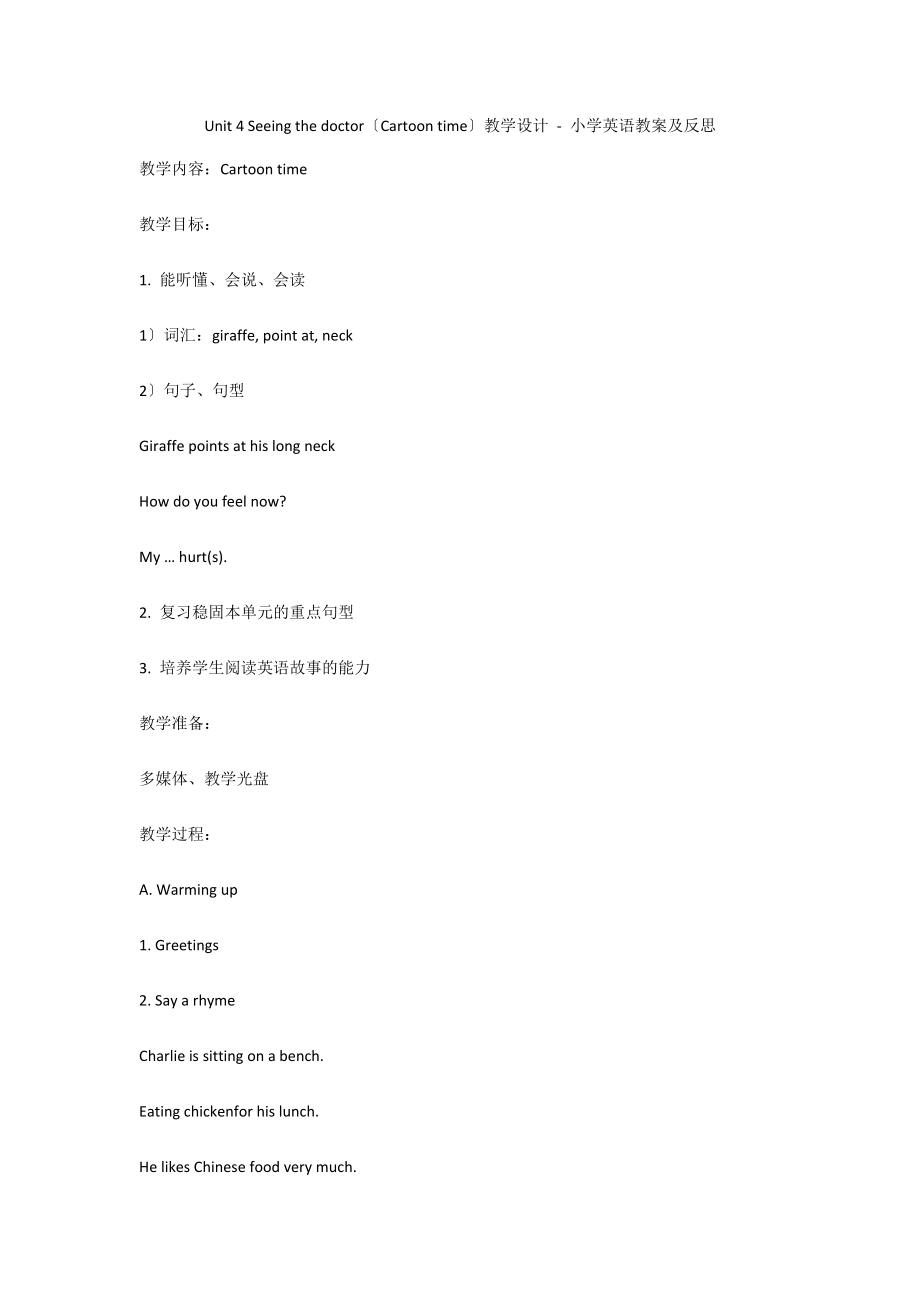《Unit 4 Seeing the doctor(Cartoon time)教學(xué)設(shè)計(jì) - 小學(xué)英語(yǔ)教案及反思》由會(huì)員分享,可在線閱讀���,更多相關(guān)《Unit 4 Seeing the doctor(Cartoon time)教學(xué)設(shè)計(jì) - 小學(xué)英語(yǔ)教案及反思(2頁(yè)珍藏版)》請(qǐng)?jiān)谘b配圖網(wǎng)上搜索�。
1����、Unit 4 Seeing the doctor〔Cartoon time〕教學(xué)設(shè)計(jì) - 小學(xué)英語(yǔ)教案及反思
教學(xué)內(nèi)容:Cartoon time
教學(xué)目標(biāo):
1. 能聽(tīng)懂、會(huì)說(shuō)、會(huì)讀
1〕詞匯:giraffe, point at, neck
2〕句子、句型
Giraffe points at his long neck
How do you feel now?
My … hurt(s).
2. 復(fù)習(xí)穩(wěn)固本單元的重點(diǎn)句型
3. 培養(yǎng)學(xué)生閱讀英語(yǔ)故事的能力
教學(xué)準(zhǔn)備:
多媒體���、教學(xué)光盤
教學(xué)過(guò)程:
A. War
2���、ming up
1. Greetings
2. Say a rhyme
Charlie is sitting on a bench.
Eating chickenfor his lunch.
He likes Chinese food very much.
He’s going to China in March.
B. Revision
1. 出示動(dòng)詞短語(yǔ)卡片,學(xué)生認(rèn)讀并造句
2. 請(qǐng)幾組學(xué)生選擇Fun time中的一組卡片���,編創(chuàng)對(duì)話����,上臺(tái)表演
C. Cartoon time
1. 猜謎游戲,導(dǎo)入故事
教師描述故事中的動(dòng)
3���、物患者的外貌特征����,學(xué)生猜想是什么動(dòng)物
It is funny. It can climb trees. It like bananas and peaches. (monkey)
It has long ears. It has a short tail. It can jump. (rabbit)
It is big and strong. It has large ears. It has long teeth and a long nose. (elephant)
It is very tall. It has a long neck and small ears. (giraffe)
引導(dǎo)學(xué)生學(xué)習(xí)詞匯:giraffe,neck.
2. 播放本局部動(dòng)畫���,學(xué)生觀看動(dòng)畫�����,理解故事大意���。
3. 學(xué)生獨(dú)立閱讀故事。檢測(cè)理解Read and writeWhoWhat’s wrong?After treatmentMonkeyarmcan’t writeRabbitearcan’t hearElephantnosecan’t eat or drinkGiraffeneck?
 Unit 4 Seeing the doctor(Cartoon time)教學(xué)設(shè)計(jì) - 小學(xué)英語(yǔ)教案及反思
Unit 4 Seeing the doctor(Cartoon time)教學(xué)設(shè)計(jì) - 小學(xué)英語(yǔ)教案及反思

